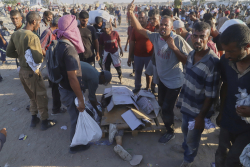Even after the atomic bombs were dropped on Hiroshima and Nagasaki, it was not universally expected that Japan would capitulate.
Arguably, one of the most famous photos in history was taken 80 years ago today. Often dubbed “The Kiss,” the iconic image showed a sailor kissing a nurse in New York City’s Times Square. It was taken by Life magazine photographer Alfred Eisenstaedt immediately after news broke that the Empire of Japan had surrendered, essentially ending the Second World War. Other photos, including one taken by William C. Shrout, showed the embrace from another angle, and by the look on the faces of those around, it was a moment of celebration.
However, even before the #MeToo movement, the photo gained infamy as it was learned that Greta Zimmer Friedman, the woman being kissed, did not consent. The sailor, George Mendonsa, had been kissing several women. Still, before she passed away in 2016, Friedman acknowledged that the photos became iconic because she was wearing a white dress as she was a dental assistant, and Mendonsa was in his blue uniform.
“It was a wonderful coincidence, a man in a sailor’s uniform and a woman in a white dress … and a great photographer at the right time,” Friedman told CBS News in 2012.
Americans Feared Japan Would Keep Fighting for Years
It was not just Mendonsa, a sailor on leave who admitted to having had a few drinks, doing the kissing on August 14, 1945. There are hundreds of stories of individuals embracing, most of a more consensual nature, on that day. December 7, 1941, may continue to live in infamy, as the United States was unexpectedly attacked at Pearl Harbor and other bases in the Pacific, yet August 14 was equally unexpected. That part of the story is largely forgotten, especially eight decades later. Japan’s cities were indeed being bombed, that its once mighty navy was mainly at the bottom of the ocean, and it was on the verge of invasion.
However, only two weeks earlier, Americans were expecting the war to continue. Although Nazi Germany was defeated, there were no plans to demobilize, and instead, a significant number of American troops were going to be redeployed to the Pacific.
As many as 400,000 soldiers were to be sent from Europe beginning in September 1945 and continuing to January 1946, with about one million in total expected to mass for an invasion of Japan by April 1946.
Even after the atomic bombs were dropped on Hiroshima and Nagasaki, it was not universally expected that Japan would capitulate.
Why Did Japan Really Surrender?
The Japanese military leadership, led by General Tojo, employing the traditional Bushido Code that derived from the samurai era, embraced a no-surrender policy. It was simply unthinkable for many in leadership roles to accept that surrender was preferable to death.
This policy was instilled across the military, which considered surrender dishonorable.
It was only after the two atomic bombs were dropped, which was followed by the Soviet Union’s declaration of war, that Emperor Hirohito intervened, realizing that continued resistance was futile, which would simply lead to the destruction of Japanese civilization.
Although the Potsdam Declaration had called for an unconditional surrender, Japan’s surrender was conditional in the sense that it required the preservation of the Emperor as the head of state.
While VJ-Day may be August 14, it was not until September 2, 1945, aboard the United States Navy’s Iowa-class battleship USS Missouri (BB-63) that arrived in Tokyo Bay, that Japanese Foreign Minister Mamoru Shigemitsu and General Yoshijirō Umezu formally surrendered to General Douglas MacArthur, who represented the Allied Powers. That marked the end of the Second World War, but by then the celebrations had already begun.
About the Author: Peter Suciu
Peter Suciu has contributed over 3,200 published pieces to more than four dozen magazines and websites over a 30-year career in journalism. He regularly writes about military hardware, firearms history, cybersecurity, politics, and international affairs. Peter is also a contributing writer for Forbes and Clearance Jobs. He is based in Michigan. You can follow him on Twitter: @PeterSuciu. You can email the author: [email protected].
Image: Wikimedia Commons.

















